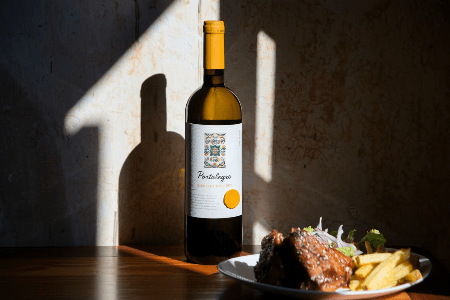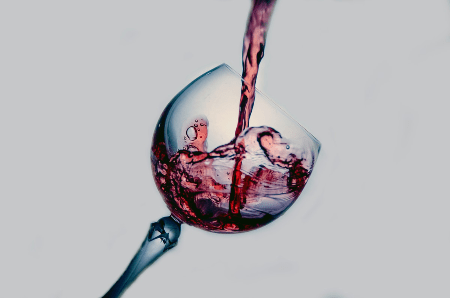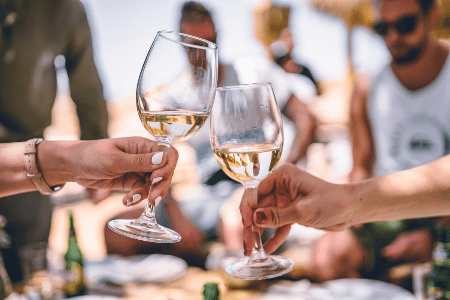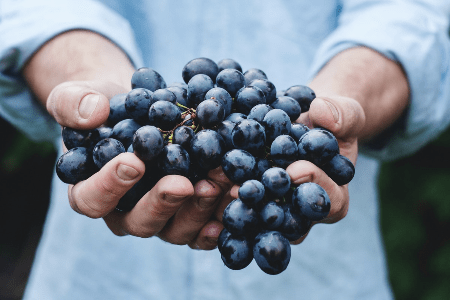Ultimate Cooking Guide by Roger Keyserling (no david read aloud TXT) 📖

- Author: Roger Keyserling
Book online «Ultimate Cooking Guide by Roger Keyserling (no david read aloud TXT) 📖». Author Roger Keyserling

Wine is used to make a regular meal and an extraordinary experience or a typical hangout into a memorable moment. Wine can, however, be very intimidating, especially if you are new to it. Wine is very different, and each has its taste, and when wrongly matched with a certain food, the result can be devastating. Wines often have very complex descriptions, some of which you need to learn. According to research, knowing the wine you are taking makes it's tastier and more enjoyable.
Whether you are a beginner or a profession in the wine industry, the following article will give you a breakdown of everything you need to know about wine and how to make the most of the wine.
 Wine basics
Wine basics
The most basic guide to wine is understanding wine according to its color and where it gets its color. Wines are made from grapes, and grapes contain a substance called tannin. When the grapefruit ferments, the skins may allow the tannin to get into the wine. Contact with the skin is what gives the wine the white or red color. Wines that have the coats on when fermenting will have more tannin, and they often end up red due to the contact with the skin. Wines that have no skin contact end up having less tannin, and they are white or pink as grapes are naturally white inside.
Redwine can describe as bitter or firm due to the tannin in them. Tannin also makes it smooth or soft and bolder. Tannins get bitter when cold, so it is not advised to drink chilled red wine. Some examples are merlot pinot noir and Malbec.
White wine does not have enough tannin but has some acidity. A flat wine will have small acidity, and white wine with enough acidity can be described as tart
Some popular white wines are chardony semmilion and moscato.
Rose is ordinarily pink in color. It has minimal contact with the skin; thus, the pink color and low tannin.they are more similar to white wine. Examples pinot noir and zinfandel
What Is Dessert Wine and Sparkling Wine
The rose, red and white wine typically have an alcohol percentage of 14% and below. Some different wines are however modified, and some alcohol is added in them, and this makes the sparkling wines
A dessert wine is mostly taken after a meal. Brandy is generally added to the wine. The wine retains its natural sugars, which aids in fermentation.
Sparkling wine is a type of wine that has significant carbon in it. The carbon can occur naturally during fermentation or can be added typically. The wine can be made either red or white, and the wines indicate whether they are sweet or dry. Champagne is an example of sparkling wine.
There’s no right way or wrong way to taste wine. It’s as simple as, do you like what you’re drinking or do you not like what you’re drinking? That said, there’s a formal way to taste a wine that reveals more about the wine in your glass, even before you start drinking. Before we start tasting wine let us learn a bit about it.
Wine is the fermented juice of grapes Sugar + Yeast = Alcohol + Carbon Dioxide (CO²) The sugar is in the grape juice and the yeast is present on the grape skins and in the air Fermentation ends when the alcohol reaches around 15%
Three major types of wine
• Table wine: 8-15% alcohol
• Sparkling wine: 8-12% alcohol + CO²
• Fortified wine: 17-22% alcohol (All wine fits into at least on of these categories)
Wine is an alcoholic drink typically made from fermented grapes. Yeast consumes the sugar in the grapes and converts it to ethanol, carbon dioxide, and heat. Different varieties of grapes and strains of yeasts produce different styles of wine. Wine is an alcoholic drink made from fermented grapes. ... Wine has been produced for thousands of years. The earliest known traces of wine are from Georgia (c. 6000 BC), Iran (c. 5000 BC), and Sicily (c. 4000 BC) although there is evidence of a similar alcoholic drink being consumed earlier in China (c. 7000 BC). Quoted From:
Wikipedia

A glass of red wine (5 ounces) a day has long been praised as good for your ticker. But newer research has also linked moderate alcohol consumption — including white wine and other beverages — to lower risk of heart failure and improved blood pressure.
The Winemaking process Freshly picked grapes are sorted De-stemmed and crushed Placed into a vat with (red) or without skins (white) Fermentation occurs (4- 20 days) Pressed Barreled and aged Filtered and bottled
Most wine is made with grapes, but they're not like the ones you find in the grocery store. Wine grapes (Latin name: Vitis vinifera) are smaller, sweeter, have thick skins, and contain seeds. There are over 1,300 wine grape varieties used in commercial production but only about 100 of these varieties make up 75% of the world's vineyards.
A wine beginner might know the basic differences between a red and a white, but it’s also important to learn all the wine types and varietals. You can explore everything from Chardonnay to Viognier and Cabernet Sauvignon to Zinfandel
Top Red Wine Varietals and Taste
Cabernet Sauvignon
The two are related: Cabernet Sauvignon is a cross between Sauvignon Blanc and Cabernet Franc. But Cabernet Sauvignon is a red wine grape and has success in many parts of the world, most notably in California's Napa Valley and France's Bordeaux region, where it is blended with other grapes to make stately red wines
Taste: Dark, ripe fruits, black cherry, plum, spice, vanilla, cedar or oak from barrel-aging
Body: Heavy
Notable Growing Regions: Grown in every wine-producing country, well-known styles from California, France (Bordeaux)
Food Pairing: Grilled meats, roasted meats- beef, lamb
Pinot Noir
A good Pinot Noir is one of the safest red wines, along with Merlot, to serve a big group of people. ... Like many other regions of France, Pinot Noir producers do not refer to their Pinot Noir wine as Pinot Noir, but instead call it red Burgundy, after the region where it's made
Taste: Red fruits, bright cherries, strawberry, some spice, vanilla,
Body: Light
Notable Growing Regions: France (Burgundy), California, Oregon, Australia (Yarra Valley), New Zealand (Otago Valley), Italy (Northern)
Food Pairings: Light, flavorful meats - duck, pork, chicken thighs; mushrooms; salmon and heavy flavored fish
Bordeaux Red Blends (Meritage)
*Mimic the style of Bordeaux reds from the Bordeaux region of France. This blend is generally dominated by Cabernet Sauvignon, but also utilize other grapes like Cab Franc, Merlot, Malbec
Taste: Big, bold, dark fruits,; savory flavors; mineral flavors; tannic (drying); cedar, oak, vanilla
Body: Heavy
Notable Growing Regions: Produced throughout the world, notable from California, Chile, similar to Bordeaux blends from France
Food Pairings: Smoked meats, roasted meats; lamb; firm cheese
Malbec
Malbec is a full-bodied red wine that grows mostly in Argentina. Known for its plump, dark fruit flavors and smoky finish, Malbec wine offers a great alternative to higher-priced Cabernet Sauvignon and Syrah. However, there's more to Malbec than just value
Taste: Dark berry, cherry, black pepper spice, cocoa, wet earth
Body: Medium
Notable Growing Regions: Argentina (Mendoza), France
Food Pairings: Pasta, Barbecue or grilled meats, spicy food
Merlot
Merlot is a dark blue-colored wine grape variety, that is used as both a blending grape and for varietal wines. The name Merlot is thought to be a diminutive of merle, the French name for the blackbird, probably a reference to the color of the grape.
Taste: Raspberries, strawberries, mineral, cedar
Body: Medium
Notable Growing Regions: France (Bordeaux), Washington, California, Italy (Tuscany), Australia (South Australia)
Food Pairings: Many foods from chicken and pork to dark meats

Top White Wine Varietals and General Taste
Chardonnay
Chardonnay is the world's most popular white wine, and for good reason. It's made from green-skinned grapes that adapt to a variety of climates, and they produce versatile wines in many price points. Chardonnay can be crisp and clean, or rich and oaky
Taste: Wide range depending on style; lemon, apple, pear, bright fruits; mango, pineapple, peach, tropical fruits; vanilla, butter, baked goods, coconut
Body: Medium
Notable Growing Regions: France (Chablis, Burgundy), Italy, California, New York, Australia (South Australia)
Food Pairings: Fish, lightly seasoned chicken, soft cheeses
Sauvignon Blanc
Sauvignon Blanc is a white wine that owes much of its popularity to winemakers in Bordeaux and the Loire Valley in France. The Sauvignon Blanc taste is very different from other white wines, like Chardonnay, because of its green and herbaceous flavors.
Taste: Green fruits, lime, green bell pepper, pear; stonefruit, kiwi, peach; oaked, vanilla, coconut, butter
Body: Medium to Medium-heavy
Notable Growing Regions: France (Bordeaux, Loire Valley), Italy (Northeast), New Zealand (Marlborough, Hawkes Bay), California, Chile
Food Pairings: White meats, chicken, pork; white fish, shellfish, lobster, clams; soft, sour cheese

Pinot Grigio/Pinot Gris*
*The same grape, called Pinot Grigio in Italy, Pinot Gris in France
Taste: Italian, lime, pear, sour apple; France, lemon, honey, honeysuckle; U.S., white nectarine, ripe stonefruits
Body: Medium to Medium-heavy
Notable Growing Regions: Italy, France, U.S.
Food Pairings: Fresh fish, green salads, shellfish
Rosé
Rosé is a type of wine made from red wine grapes, produced in a similar manner to red wine, but with reduced time fermenting with grape skins. This reduced skin contact gives rosé a pink hue and lighter flavor than that of red wine.
Taste: Varying styles; Light, rose petal, underripe strawberry, limestone; Medium, strawberry, summer fruits; Heavy, ripe fruits, floral, spice hints
Body: Light to Medium-heavy
Notable Growing Regions: France, Spain, California, Italy
Food Pairings: Dependent on style anything from light salads to barbecued meats
After you’ve tasted the wine, now you have the opportunity to consider the wine’s quality. Here are some of the questions to ask yourself:
Is the wine in balance? This is a question referencing the notes you made in the tasting section. Wines that are “in balance” have tastes that are balanced between one-another including acidity, tannin (if it’s red), and alcohol level. While different wines have different intensities, a quality wine will be in balance with itself. Is the wine complex? If you have a great deal of tasting notes for this wine and can still think of more, you’ve got a pretty complex wine on your hands. What is your opinion? Now that you’ve properly assessed the wine, what do you think of it (overall)? We use a very simple 3-point system for this assessment (ew, meh, yay!) but you can use any kind of rating system that works for you.
Reading a Wine Label
At first glance, a wine label can be confusing to those just getting started. Luckily, New World wine producers have made it easier on wine beginners by listing the grape(s) directly on the label. Old World regions have typically relied on the wine consumer to be familiar enough with the region to know, for example, that Red Burgundy is Pinot Noir.
Old World Wines might read like this:
Château Moulin de Grenet 2009 Lussac Saint-Émilion
New World wines might read like this:
Cakebread 2006 Merlot, Napa Valley
Smelling Wine
When you go to smell the wine, stick your nose all the way into the glass and close your eyes — sure you might feel silly doing it, but you’re going to notice a lot more smells this way — then breathe in deep. As you smell





Comments (0)